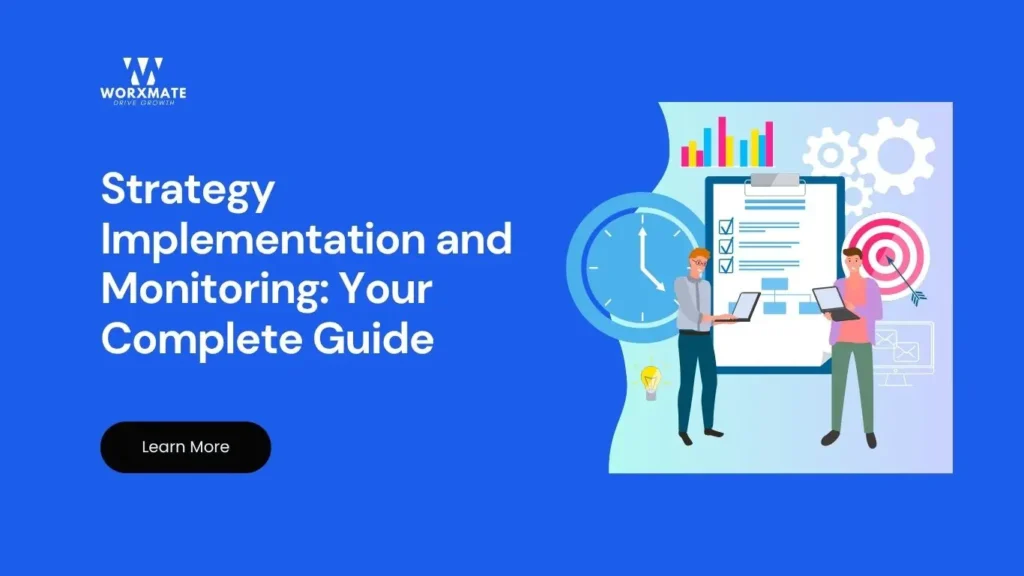Summary:
Strategy implementation and monitoring is the systematic process of putting strategic plans into action while continuously tracking progress and measuring results. It transforms strategic visions into tangible outcomes through coordinated execution, resource allocation, and performance measurement. This approach ensures organizations achieve their goals while adapting to challenges and opportunities along the way.
Why Strategy Implementation and Monitoring Determines Your Success
Imagine having the perfect roadmap to your destination but never checking if you’re on the right path. That’s exactly what happens when organizations develop brilliant strategies but fail at strategy implementation and monitoring.
Here’s a sobering reality: research shows that 70% of strategic initiatives fail during execution. The difference between successful and struggling organizations isn’t the quality of their strategies—it’s their ability to implement and monitor them effectively.
Strategy implementation and monitoring serves as your organization’s GPS system, ensuring you not only move toward your goals but also course-correct when needed. Whether you’re a startup scaling rapidly or an established enterprise pursuing transformation, mastering this dual approach is crucial for sustainable success.
In today’s rapidly changing business landscape, the ability to execute strategies while monitoring their effectiveness separates industry leaders from the rest. Let’s explore how you can join the ranks of organizations that consistently turn strategic plans into measurable results.
What is Strategy Implementation?
Strategy implementation is the systematic process of putting strategic plans into action to achieve desired organizational goals. It involves translating high-level strategic objectives into specific activities, allocating resources, and coordinating efforts across departments.
Think of strategy implementation as building a bridge between your strategic vision and operational reality. It requires more than just good intentions—it demands structured execution, clear accountability, and continuous coordination.
Core Components of Implementation Strategy
Successful implementation strategy encompasses several critical elements:
- Resource allocation: Ensuring adequate financial, human, and technological resources
- Role clarity: Defining specific responsibilities for team members and departments
- Process alignment: Synchronizing operational processes with strategic objectives
- Cultural integration: Aligning organizational culture with strategic direction
The implementation process transforms abstract strategic concepts into concrete actions that drive measurable business outcomes.
The Strategy Implementation Process: A Step-by-Step Approach
Step 1: Develop a Comprehensive Action Plan
Before implementing anything, create a detailed strategic implementation plan that serves as your execution blueprint. This plan should include:
- Clear objectives and success metrics
- Detailed timelines and milestones
- Resource requirements and allocation
- Risk assessment and mitigation strategies
Step 2: Set Clear, Measurable Goals
Define specific goals that align with your overall strategic vision. These goals should be:
- Specific: Clearly defined outcomes
- Measurable: Quantifiable success metrics
- Achievable: Realistic given available resources
- Relevant: Aligned with strategic objectives
- Time-bound: Clear deadlines and timelines
Step 3: Assign Roles and Responsibilities
Successful strategy implementation requires clear accountability. Assign specific roles to team members and ensure everyone understands:
- Their individual responsibilities
- How their work contributes to larger objectives
- Reporting structures and communication channels
- Decision-making authority and escalation processes
Step 4: Execute with Precision
Launch your strategic initiatives while maintaining focus on quality execution. This phase requires:
- Regular progress reviews
- Proactive problem-solving
- Resource optimization
- Stakeholder communication
Strategy Implementation and Monitoring: A Unified Approach
Monitoring and evaluation form the critical feedback loop that ensures your strategy implementation stays on track. This systematic approach involves continuously tracking progress, measuring outcomes, and making data-driven adjustments.
The Monitoring Framework
Effective monitoring focuses on several key areas:
- Performance Tracking: Regular assessment of key performance indicators (KPIs) that measure progress toward strategic objectives.
- Resource Utilization: Monitoring how effectively your organization uses financial, human, and technological resources during implementation.
- Timeline Management: Ensuring activities are completed within established timeframes while maintaining quality standards.
- Outcome Measurement: Evaluating actual results against expected outcomes to determine strategy effectiveness.
Evaluation for Continuous Improvement
Evaluation goes beyond monitoring by analyzing the deeper impact and effectiveness of your strategy implementation:
- Goal Achievement Analysis: Assessing whether strategic objectives have been met
- Efficiency Evaluation: Determining how well resources were utilized
- Impact Assessment: Understanding the broader organizational and market effects
- Cost-Benefit Analysis: Comparing implementation costs to achieved benefits
Case Study: Gartner’s Strategic Transformation Success
A compelling example of effective strategy implementation and monitoring comes from a recent Gartner case study involving a private equity-acquired organization.
The Challenge
A newly appointed CFO faced a significant challenge: develop a comprehensive capital allocation and M&A strategy within six months to present to the board. The organization needed to capitalize on aggressive growth opportunities following its private equity acquisition.
The Implementation Approach
Working with Gartner, the organization implemented a structured approach that included:
- Best Practice Integration: Adopting proven strategies from leading “efficient growth” companies
- Tool Utilization: Using customizable templates for M&A, tax, and cultural due diligence
- Comprehensive Planning: Developing an M&A strategy that addressed approach, targets, pipeline, and internal capability building
- Continuous Feedback: Regular strategy reviews and iterative improvements
Remarkable Results
The results demonstrated the power of effective strategy implementation and monitoring:
- Accelerated Timeline: The strategy was completed in half the expected time
- Board Approval: The comprehensive strategy received full board backing
- Enhanced Capabilities: The organization built robust internal capabilities to support ongoing strategic initiatives
This case illustrates how structured implementation combined with continuous monitoring can dramatically accelerate strategic success.
Best Practices for Strategy Implementation and Monitoring Excellence
Create Visual Dashboards
Develop real-time dashboards that provide instant visibility into key metrics. These visual tools enable quick decision-making and keep stakeholders informed about progress.
Establish Regular Review Cycles
Implement structured review meetings to assess progress, identify challenges, and make necessary adjustments. Consider weekly operational reviews and monthly strategic assessments.
Foster Cross-Functional Collaboration
Success requires coordination across departments. Establish clear communication channels and collaborative frameworks that break down silos.
Invest in Technology and Tools
Leverage project management software, analytics platforms, and collaboration tools to streamline implementation and enhance monitoring capabilities.
Build a Culture of Accountability
Create an environment where team members take ownership of their contributions to strategic success. Recognize achievements and address performance gaps promptly.
Transform Your Strategy Implementation with Worxmate
Effective strategy implementation and monitoring requires the right tools and frameworks to succeed. This is where Worxmate’s comprehensive OKR software becomes your strategic advantage.
Worxmate streamlines your entire implementation process by providing:
- Clear Goal Alignment: Connect individual objectives with organizational strategy
- Real-Time Progress Tracking: Monitor implementation progress with intuitive dashboards
- Accountability Framework: Ensure every team member understands their role in strategic success
- Data-Driven Insights: Make informed decisions based on comprehensive analytics
Don’t let your brilliant strategies fail at execution. Ready to transform your strategy implementation and monitoring process? Book A Free Demo with Worxmate today and experience the difference that structured execution makes for your organization’s success.



